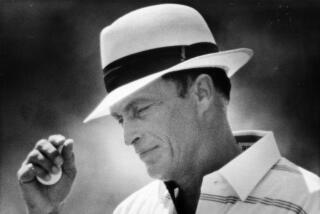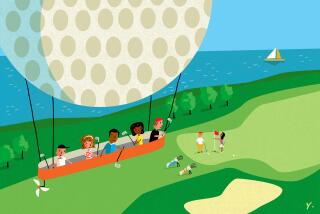It can be a tough lesson finding the right teaching pro
Dirk WIETSTOCK made a vow. He would become a better golfer . . . no, he would become a really good golfer. He wasn’t intent on shaving a couple of strokes off his 18 handicap; he wanted to lop off a dozen or more.
Vice president of a City of Industry marble and tile business with job sites across the West, he knew the commitment would mean carving precious hours from an already dawn-to-well-past-dusk schedule, but he was determined to find the time and make the effort.
“I’m almost 50, so I figured it made no sense to waste any more time swinging incorrectly,” he said. “I’m not talking about a club-head speed of 135 mph, but there’s no reason I couldn’t learn to get the club in the proper place. I’m athletically inclined, and I think I’ve got the head to do it.”
Wietstock knows about the importance of mechanics. He was the ace of the UC Irvine pitching staff in the early ‘80s, and he can still wow guys half his age with his prowess at shortstop on the softball diamond. But that athleticism was in some ways a curse to his progress on the golf course.
“Distance was never a problem,” he says. “I drove it 270 on cold, early-morning rounds and up to 325 in the desert. But there was no fairway wide enough.”
For many golfers, making a determined commitment to improve may be the easy part. Sure, finding someone who teaches the golf swing is about as difficult as finding a Starbucks, but finding the right golf instructor is akin to finding a soul mate.
Anyone who has picked up a club has probably had some form of instruction . . . usually the kind of counsel that should have been ignored. But that doesn’t mean guidance at a price is necessarily any more helpful.
Some teaching pros just want to make a few adjustments, tweak your stance, grip, alignment, swing plane, waggle, wrist cock, shoulder turn and angle of attack. For most, the mantra is: Keep it simple. But it seldom is.
In order to dissect your swing, some have computer setups that rival NASA’s; others say they need only watch you hit a couple of balls. Some use beach balls, broomsticks and contraptions that look like they came out of a medical supply catalog; others just want you to swing in front of a mirror.
It can all be very confusing.
--
WHAT PRICE GLORY?
There are, of course, a few obvious considerations when it comes to golf instruction. How much are you willing to pay -- $7,000 for a private half-day session with David Leadbetter or $35 for a half-hour with the guy at the driving range? How well do you currently play? How often do you play? And what are your expectations? They shouldn’t be great unless you intend to practice, practice, practice.
Oh and that magic bullet? There isn’t one.
Just ask Eddie Merrins, the venerable “Little Pro” at Bel-Air Country Club, who has been passing on knowledge of the golf swing to the world’s best players, Hollywood celebrities and the members of one of America’s most exclusive clubs for almost 50 years. Byron Nelson called Merrins “one of the best teachers of anybody I know.”
So you ask Merrins about his worst student and he says “the ones who seem to wake up with the notion that this is going to be the day when greatness descends.”
Merrins, 75, who wrote the book “Swing the Handle, Not the Clubhead” in 1973, says he hasn’t changed his basic philosophy of teaching since it “occurred to me in the late ‘50s.” He has, however refined how he gets his point across.
“It’s an intriguing game, golf, but it may be the worst-taught game ever devised,” he said. “We dream up ways to make it more complicated and try to dazzle with our knowledge. The student comes in with a question, something they want to work on, and they deserve an answer. We can overload them with a lot of fact and fiction, but they won’t find the answer.
“It’s like somebody with an illness goes to a pharmacy. They need a remedy, but they don’t need to buy the whole store.”
Dean Reinmuth, who tutored Phil Mickelson in his teens and currently works with PGA pros Rory Sabbatini and Ricky Barnes, focuses on making adjustments to a golfer’s natural swing instead of starting from scratch. He says the average player needs to make no more than five key changes, probably fewer.
“The No. 1 most critical factor of good golf instruction is in the analysis. If you misdiagnose the cause of the problem, you go nowhere.
“And the swing itself is in sequential order, so you have to find where the dominoes are going to fall. It’s like baking a cake, the right ingredients aren’t enough, they have to be combined in the right order.”
Brady Riggs, the director of instruction at Woodley Lakes Golf Club in Van Nuys and senior instruction editor at Golf Tips magazine, loves his job, but he’s not proud of his profession.
“More often than not, the information [stinks] and not the student,” he says. “It’s bad out there. We fail our students way too often. There’s no reason on earth to make someone confused, but it happens all the time. If you’ve got a good teacher, you really kind of got lucky.”
But he has some tips on how to find a good one.
“Go to two or three local courses, find 10 players that look pretty good and ask them,” he said. “Sure, it’s an unscientific survey, but a name will pop up. And you want to make sure your instructor has video. It really helps all levels of golfers to be able to see their swing and if [the instructor] invested several grand into a video system, at least you know they’re committed to their job.”
--
ONE ‘L’ OF A SWING
Wietstock went to a free clinic offered by Randy Chang at Arroyo Trabuco Golf Club in Mission Viejo. He liked Chang’s easygoing nature and bent for humor, but he also was intrigued with the tenet of Chang’s philosophy: Every pro golfer’s swing is exactly the same between the “L’s” -- the positions in the backswing and the follow-through where the arms and the club shaft create an L-shape.
So Wietstock took a lesson.
“He told me to grab my seven-iron and hit a few balls while he ran the video camera,” he said. “Well, I absolutely [nailed] five straight shots, couldn’t have hit them any better, and I thought, ‘What’s he going to find to criticize about that?’ ”
Plenty. Chang said “that swing will not get you where you want to go,” and a new swing was born. Soon, Wietstock found himself on the range, with half a backswing and half a follow-through, trying to master that place between the Ls where the club head is aligned and meets the ball.
“He wouldn’t let me on the course for eight weeks,” he said. “It took all of my energy to stick with it. You see some guys two stalls down ripping it and you’ve got half a swing. But I stayed with the drill and did exactly what Randy told me.”
Greatness has yet to descend upon him and you won’t see him on the Champions Tour next year, but Wietstock says there are tangible results: He’s hitting the ball much straighter, if a bit shorter, and he says he can honestly feel what he did incorrectly if a shot goes awry.
“And I can turn a ball either way, fade or draw, on purpose . . . really, can you imagine that?”
--
John Weyler
More to Read
Go beyond the scoreboard
Get the latest on L.A.'s teams in the daily Sports Report newsletter.
You may occasionally receive promotional content from the Los Angeles Times.










